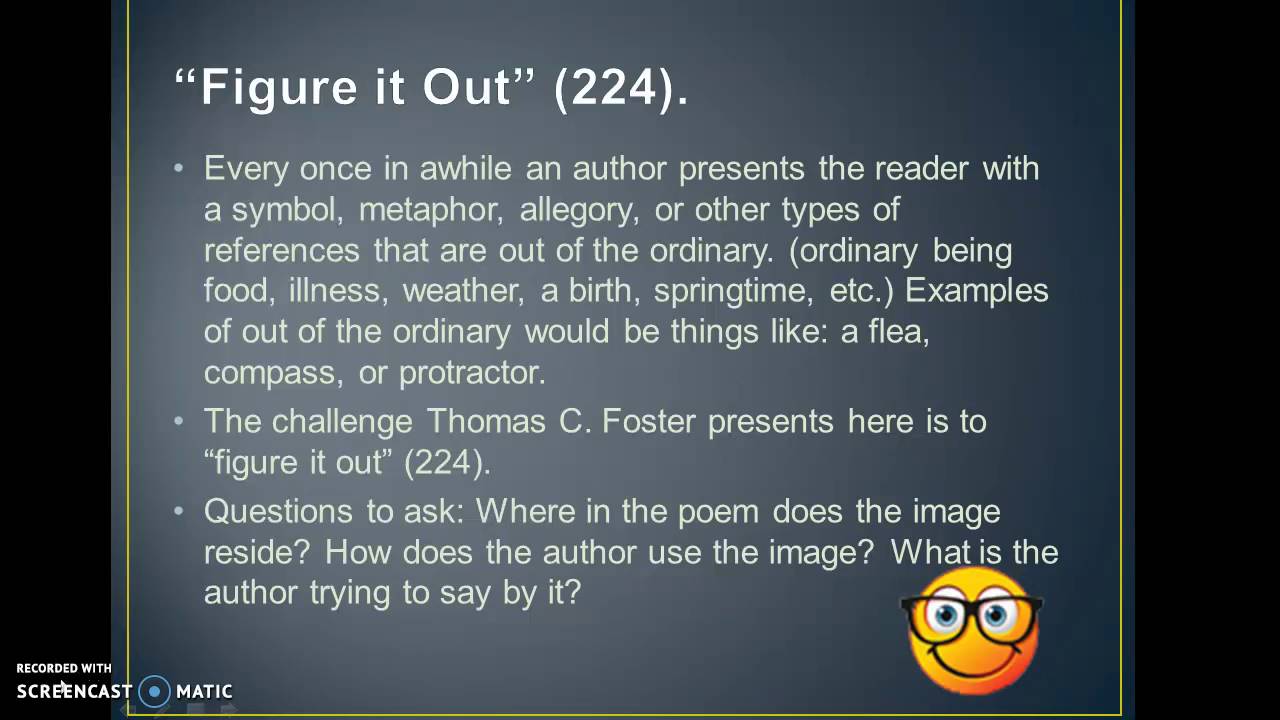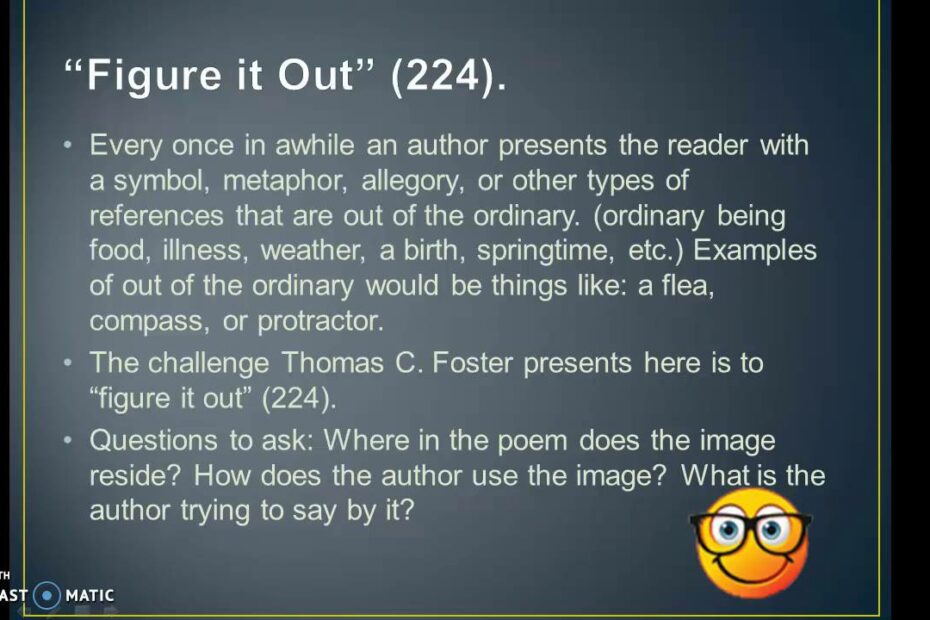Let’s discuss the question: how to read literature like a professor chapter 25. We summarize all relevant answers in section Q&A of website Achievetampabay.org in category: Blog Finance. See more related questions in the comments below.

What is Foster’s main point in Chapter 25?
As Foster argues here, the best formula is to simply have faith in yourself and your instincts. Modernist literature can be particularly intimidating and impenetrable, and part of the problem is that every modernist text exists in something of a world of its own.
What is the meaning of Chapter 27 in how do you read literature like a professor?
This short story symbolizes superiority in a way that shows the differences between wealthier classes opposed to the less fortunate.
How To Read Literature Like a Professor Ch 25 \u0026 26
Images related to the topicHow To Read Literature Like a Professor Ch 25 \u0026 26

How do you read literature like a professor?
- Poems of W. H. Auden by W. H. Auden. …
- Waiting for Godot by Samuel Beckett. …
- Beowulf by Unknown. …
- Hotel du Lac by Anita Brookner. …
- Alice’s Adventures in Wonderland by Lewis Carroll. …
- Through the Looking Glass by Lewis Carroll.
What does don’t read with eyes mean?
The point is not to read with “your eyes,” or, in other words, not to read only from your own particular historical, cultural, and individual perspective. Letting go of one’s own particular perspective is not a matter of familiarizing oneself with every possible cultural and historical context.
What trumps all about literature?
“Irony trumps everything” is a useful phrase to remember, although it is not initially completely clear what it means. In “trumping everything,” irony doesn’t eliminate other layers of meaning.
What are the three types of irony?
The three most common kinds you’ll find in literature classrooms are verbal irony, dramatic irony, and situational irony. Verbal irony occurs whenever a speaker tells us something that differs from what they mean, what they intend, or what the situation requires.
How can you tell if something is ironic?
In general, irony refers to a clash between expectations and outcomes. Typically, the outcome is the opposite of what someone wanted or hoped for. It’s ironic, for example, when your boss calls you into her office, and you’re expecting a promotion, but you instead find out you’ve been fired.
What is Foster’s main argument in Chapter 27?
Foster’s argument that the story is a version of the Greek myth of Persephone may seem like it is coming out of nowhere, but as he explains, this is not necessarily the case. To support his claim, Foster points out that Persephone’s mother is Demeter, the Greek goddess of agriculture and fertility.
What does it mean to be marked for greatness?
Marked for Greatness. In real life, physical marks or imperfections have little, if any, meaning. Yet, in literature, an imperfection almost always is symbolic. The mark’s significance: It represents and emphasizes the importance of inner beauty.
What does spring mean in literature?
Spring has traditionally been the symbol of love, joy, spirituality, youth and melancholy and most importantly beginning of a new life for a person after suffering at the hands of the ‘cold world of autumn’.
Ch 25: Don’t Read with your Eyes: Interpretation : How to read literature like a professor
Images related to the topicCh 25: Don’t Read with your Eyes: Interpretation : How to read literature like a professor

How do memory symbol and pattern affect the reading of literature quizlet?
According to Foster, how do memory, symbol, and pattern affect reading Literature? How does the recognition of patterns make it easier to read complicated literature? Recognizing patterns in literature can enhance both the stylistic appreciation and comprehension of it, making it easier to read.
How do you read literature?
Discussing literature means you’re thinking about it, which is a vital step towards understanding it. Interact with the story. Ask yourself what you would do if you were in the same position as a character in the text. Try to put yourself in his/her place, and question the character’s thoughts, actions and motivations.
How long does it take to read how do you read literature like a professor?
How to Read Literature Like a Professor: A Lively and Entertaining Guide to Reading Between the Lines, Revised Edition. The average reader will spend 5 hours and 36 minutes reading this book at 250 WPM (words per minute).
How do you analyze literature?
When analyzing a novel or short story, you’ll need to consider elements such as the context, setting, characters, plot, literary devices, and themes. Remember that a literary analysis isn’t merely a summary or review, but rather an interpretation of the work and an argument about it based on the text.
What does foster mean when he says don’t read with your eyes?
Explain what Foster means by “Don’t read with your eyes” He means to look in the characters thoughts and perspective rather than your own.
What three items more than any other separate the professorial reader from the rest of the crowd?
“Memory. Symbol. Pattern. These are the three items that, more than any other, separate the professorial reader from the rest of the crowd.”
How do you read an anthology poem?
- Read the poem twice in a row. Take note of what you notice the second time that wasn’t so apparent in your first reading.
- Don’t skip over unfamiliar words. …
- Try to identify a meter, if there is one. …
- Notice point of view. …
- Read the poem one more time, and this time read it aloud.
What does it mean when a story is Ironized?
: to make ironic in appearance or effect.
Crash Course How to read literature like a professor 25-26
Images related to the topicCrash Course How to read literature like a professor 25-26

What is low mimetic mode?
The low mimetic mode is stories about ordinary people. The ironic mode is stories about people who are worse than ordinary people–criminals, buffoons.
How does Foster suggest that readers learn to identify trends?
How does foster suggest that readers learn to identify trends and why are trends important? Trends happen frequently; its is important to analyze the symbolic meaning behind it. Without trends, it would be difficult to catch on to the main story. What is foster’s parting advice for his readers?
Related searches
- how to read literature like a professor chapter 14 summary
- how to read literature like a professor chapter 20 summary
- how to read literature like a professor pride and prejudice
- how to read literature like a professor motifs
- how to read literature like a professor activities
- metaphors in how to read literature like a professor
- how to read literature like a professor chapter 25 prezi
- how to read literature like a professor chapter 20
- how to read literature like a professor chapter 25 summary
- how to read literature like a professor: chapter 25 prezi
- how to read literature like a professor chapter 3 quizlet
- how to read literature like a professor chapter 26 summary
- how to read literature like a professor chapter 24 summary
- how to read literature like a professor chapters
- how to read literature like a professor chapter 25 it’s my symbol
- how to read literature like a professor chapter 25 quizlet
- how to read literature like a professor literary devices
- how to read literature like a professor chapter 23
Information related to the topic how to read literature like a professor chapter 25
Here are the search results of the thread how to read literature like a professor chapter 25 from Bing. You can read more if you want.
You have just come across an article on the topic how to read literature like a professor chapter 25. If you found this article useful, please share it. Thank you very much.

